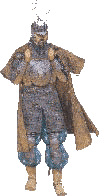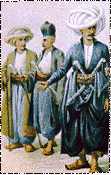| |

|
|

| |
1
OF 5 |
 |
 |
| |
Ottoman armies consisted of salaried kapıkulu
regulars, topraklı regional irregulars, short-term levied called
miri-askeris, yerli-neferats consisting of the entire Muslim population
of a town called up for a local defence, and the gönüllüyan, a general
mass of tribal irregulars.
The establishment of a regular army early in the 14th. Century saw
the emergence of Byzantine and Classical Islamic elements in th
eOttoman battle array.Byzantine influence was strong because of
the important role played by Christian vassals,particularly in siege
warfare.
By the 16th century Ottoman tactics had reached their classic form.within
a formidable system of entrenchments, top arabalari gun-waggons
and artillery stood the Sultan, his personal guard of solaks, and
the Janissaries armed with arquebuses.On their immediate flanks
were the armoured alti bölük housed cavalry.Azap infantry assambled
in front of the artillary and to the rear, where they and the muteferika
guarded the baggage train.On their flanks stood the provincial sipahi
cavalry,whose tast was to draw an enemy to the azaps.They in turn
would absorb the charge, then move aside to allow the artillery
and Janissaries to open fire. Finally the flanking sipahis would
attack and, where possible, surround the foe.The Janissaries were,
of course, also trained to attack, but they did so at a rush in
large closely-packed formations which rendered their gunfire largely
ineffective.
 Turcoman
nomads, the first element in the Ottoman army , were generally known
as akincis if they served for one campaign as volunteers receiving
booty instead of pay,and as yürüksi if they formed a tribal contingent.
Such troops were horse-archers, rarely owning more than leather
lamellar armour and still using the ancient Central Asian lassoo
as a weapon Turcoman
nomads, the first element in the Ottoman army , were generally known
as akincis if they served for one campaign as volunteers receiving
booty instead of pay,and as yürüksi if they formed a tribal contingent.
Such troops were horse-archers, rarely owning more than leather
lamellar armour and still using the ancient Central Asian lassoo
as a weapon
Ex-Byzantine troops included cavalry and infantry. Though many used
the bow, they did not employ Turcoman tactics. Most of the gazis
also seem to have fought in traditional Islamic style as mixed cavalry
and infantry.The horse men were known as müsellem (tax-free men)
and were organised under the overall command of sancak beys into
hundereds, under subasis, and thousands, under binbasis.The foor-soldiers,
or yaya, were compareably divided into tens,hunderds and thousands.These
infantry archers occasionally fought for Byzantium,where they were
known as mourtatoi.Müsellems and yayas were at first paid wages,but
by the time of Murat I (1359) they were normally given lands or
fiefs in return for military service, the yayas also having the
special responsibilty for the protection of roads and bridges.
| |
1
OF 5 |
 |
|
|


